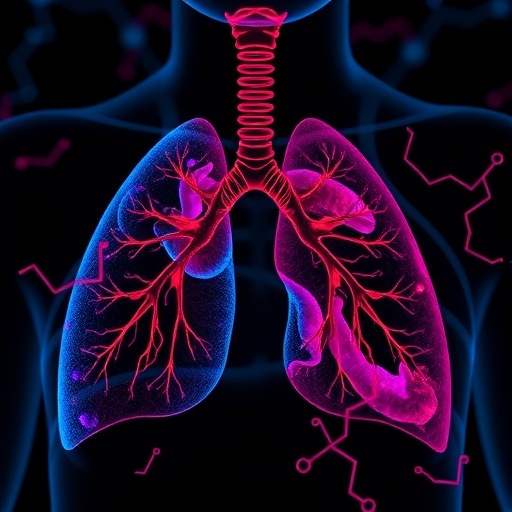Recent advancements in cancer therapeutics have brought to light an extraordinary small molecule, identified as the 3,4-diisobutyryl derivative of auxarthrol A (DAA), that demonstrates significant potential in the fight against non-small cell lung cancer (NSCLC). This discovery stems from an explorative effort involving an endophyte-derived small-molecule library, suggesting that the natural world continues to be a vital source of innovative therapeutic agents. With the ability to induce autophagy, DAA opens new avenues for targeted therapies that could revolutionize treatment paradigms in oncological care.
Autophagy, a cellular degradation process that maintains homeostasis by removing damaged organelles and proteins, plays a complex role in cancer biology. While autophagy can act as a tumor suppressor in the early stages of cancer development, its role can switch to a tumor-promoting mechanism in established cancers. Researchers are increasingly looking at how controlling autophagy through chemical means can elicit therapeutic responses, especially for aggressive forms of cancer such as NSCLC.
The recent findings regarding DAA show not only its potency as an autophagy inducer but also its capacity to sensitize tumors to anti-programmed death 1 (anti-PD1) immunotherapy. The integration of DAA into existing treatment regimens could potentially provide a dual advantage: enhancing the effectiveness of immunotherapy while directly targeting tumor growth. This dual mechanism of action may significantly improve treatment outcomes for patients suffering from NSCLC, a malignancy known for its poor prognosis and resistance to conventional therapies.
Through meticulous investigation, the research team utilized a photoaffinity labeling approach to pinpoint the direct molecular target of DAA. They identified light intermediate chain 1 (LIC1), a component of the dynein complex, as the critical target that DAA interacts with. This discovery of LIC1 as a direct target of DAA is significant, as it not only elucidates the pharmacological action of the compound but also positions LIC1 as a promising biomarker and therapeutic target in NSCLC.
Interestingly, LIC1 has been observed to be overexpressed in NSCLC tumors, suggesting a correlation between its expression levels and patient survival rates. This overexpression suggests a potential role of LIC1 in tumor progression, marking it as an attractive target for therapeutic intervention. The study indicates that high levels of LIC1 may lead to poorer clinical outcomes, thereby reinforcing the need for strategies that can effectively inhibit this protein in the tumor microenvironment.
The research elucidates the molecular mechanism through which DAA exerts its effects. When DAA binds to LIC1, it disrupts the interactions between LIC1 and RuvB-like AAA ATPase 1, a stress-sensing effector crucial for cellular response to various stressors. The inhibition of this interaction leads to an elevation in the activity of the integrated stress response pathway, primarily mediated through the GCN2-eIF2α-ATF4 axis. The subsequent downstream effects culminate in autophagic cell death, presenting a novel mechanism by which DAA can mediate antitumor effects.
Moreover, the distinct ability of DAA to promote autophagic cell death highlights its therapeutic potential. As cancer cells adapt to survive under stressful conditions, they often develop resistance to conventional treatments. By promoting autophagy in a targeted manner, DAA could override these resistance mechanisms and ultimately lead to tumor regression. This aspect of DAA’s functionality reflects a broader trend in cancer research—conventional approaches are increasingly being supplemented with strategies designed to alter the metabolic and survival pathways of cancer cells.
The implications of this research are vast. Not only does it introduce an innovative compound with dual mechanisms of action, but it also paves the way for further investigations into other potential small molecules that can induce autophagy for therapeutic benefits. This study’s findings could stimulate a paradigm shift in NSCLC treatments, integrating autophagy modulation into current therapeutic strategies.
In the realm of cancer therapy, where traditional modalities may often fall short, the success of DAA as a therapeutic agent encourages researchers to continue exploring the biochemical landscape of cancer and its microenvironment. Understanding the network of interactions affected by novel compounds such as DAA will be crucial for the future development of targeted therapies.
In conclusion, the discovery of DAA as a potent inducer of autophagy, combined with its novel targeting of LIC1 in NSCLC, exemplifies the ongoing quest for effective cancer treatments. The avenue of utilizing small molecules derived from natural sources continues to provide a treasure trove of opportunities for developing groundbreaking therapeutics. As further studies elucidate the precise mechanisms and pathways involved, we are not only inching closer to potential clinical applications but also expanding the universe of cancer biology knowledge.
The implications of this research will undoubtedly fuel discussions in the scientific community about the interplay between autophagy and cancer treatment. By targeting specific proteins such as LIC1, researchers are carving pathways that may lead to breakthroughs in how we understand cancer biology and the development of personalized medicine strategies. The revelations surrounding DAA and LIC1 are just the beginning, hinting at a future where autophagy modulation becomes a central theme in cancer treatment regimens.
As this research unfolds and therapeutic applications are realized, the scientific community and patients alike stand to benefit from the promising horizons that compounds like DAA are beginning to reveal. The integration of this small molecule into clinical practices could lead to enhanced survival rates and improved quality of life for patients battling lung cancer.
Subject of Research: Autophagy induction as a cancer treatment strategy in NSCLC
Article Title: A small molecule targets LIC1 to suppress lung tumor growth by inducing autophagy
Article References: Huang, JL., Wu, LM., Wu, SQ. et al. A small molecule targets LIC1 to suppress lung tumor growth by inducing autophagy. Nat Chem Biol (2025). https://doi.org/10.1038/s41589-025-02040-w
Image Credits: AI Generated
DOI: https://doi.org/10.1038/s41589-025-02040-w
Keywords: autophagy, non-small cell lung cancer, DAA, LIC1, immunotherapy, cancer therapeutics, small molecules, tumor growth
Tags: autophagy induction in cancercancer biology and autophagyDAA compound for lung tumorsendophyte-derived therapeuticsenhancing anti-PD1 immunotherapy effectivenessimmunotherapy sensitizationinnovative cancer treatment strategiesnatural product drug discoverynon-small cell lung cancer treatmentsmall molecule cancer therapytargeted cancer therapiestumor suppressor mechanisms





